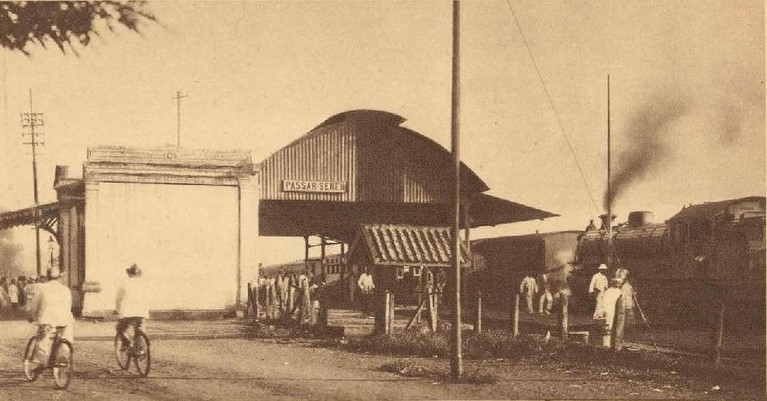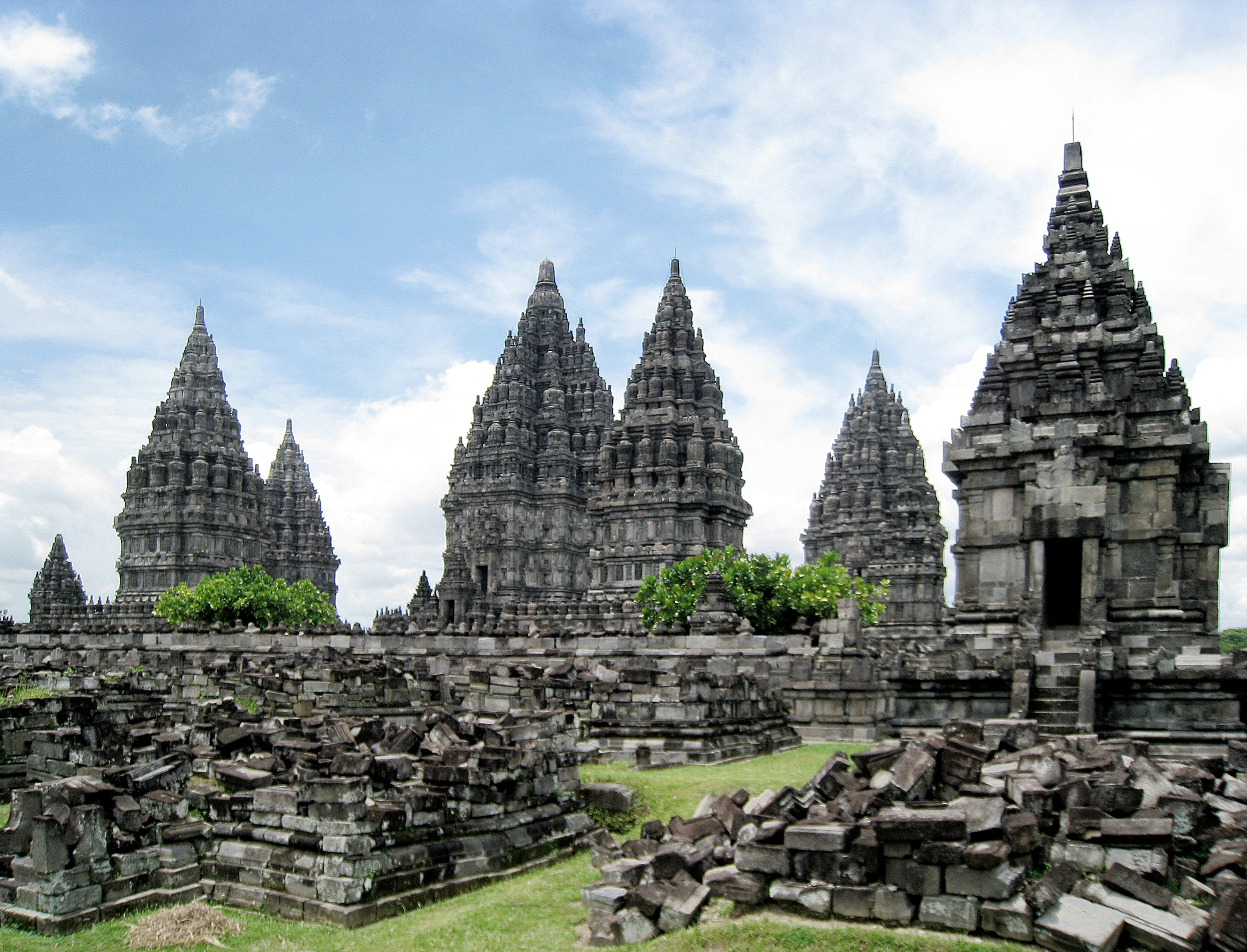|
Pasar Senen Railway Station
Pasar Senen Station is a railway station located in Jakarta, Indonesia. It is the second largest railway station in Jakarta after Gambir Station. It is located close to Pasar Senen market area in Senen, Senen, Central Jakarta. Pasar Senen only serves Economy and Business class intercity train except Gumarang and Sawunggalih. It also serves as a station for northbound KRL Commuterline trains. History The name of this train station comes from a market with the same name. It is called Pasar Senen because this market is only open on Mondays; founded by the Colonial Government in 1733 to revive the economy of the Weltevreden people who later became Gambir, Central Jakarta. During the leadership of Governor General Petrus Albertus van der Parra, Pasar Senen was getting busier so that it was open every day. Many Chinese traders opened their businesses in this market. Since independence until 1975, Pasar Senen has continued to be developed as a center for Senen trading and has become ... [...More Info...] [...Related Items...] OR: [Wikipedia] [Google] [Baidu] |
Senen, Senen, Central Jakarta
Senen is an administrative village in the Senen district of Indonesia. It has postal code of 10410. See also * Senen * List of administrative villages of Jakarta {{unreferenced, date=March 2017 This is a list of administrative villages of Jakarta. Central Jakarta Gambir * Gambir * Kebon Kelapa * Petojo Selatan * Duri Pulo * Cideng * Petojo Utara Cempaka Putih * Cempaka Putih Timur * Cempaka P ... References Administrative villages in Jakarta {{Jakarta-geo-stub ... [...More Info...] [...Related Items...] OR: [Wikipedia] [Google] [Baidu] |
Gambir, Jakarta
Gambir is a district of Central Jakarta, Indonesia. It is characterized by many historic buildings from the colonial era. It hosts some of the foremost political and learning/tourism features of the capital. The Merdeka Palace (the presidential palace of Indonesia), the National Museum, the headquarters of the Indonesian Scout Movement and the Merdeka Square (in which stands the National Monument) are among these. One of the busiest railway stations, Gambir Station, is in the focal Gambir neighbourhood (an underlying Administrative Village as the translation is usually rendered) of the district. The City Hall of Central Jakarta is in Petojo Selatan here. Limits Gambir is bordered by the Jakarta Flood Canal to the west, the river Ciliwung to the east, KH Zainul Arifin and Sukarjo Wiryopranoto Road to the north, and Kebon Sirih Raya Road to the south. Toponym The name ''Gambir'' is taken from the name of a Dutch lieutenant of French descent named Gambier, the lieutenant whom D ... [...More Info...] [...Related Items...] OR: [Wikipedia] [Google] [Baidu] |
Jatinegara Railway Station
Jatinegara Station (JNG) is a large type A-class list of railway stations in Indonesia, railway station located on the border between Jatinegara and Matraman in Pisangan Baru Subdistrict, Matraman, East Jakarta. The station is the main entrance to Jakarta from cities east of Jakarta. Jatinegara station is operated by Kereta Api Indonesia and Kereta Commuter Indonesia. All but a few intercity trains originating ''from'' cities east of Jakarta stop at Jatinegara; however, all trains heading ''to'' those cities pass the station. The government is planning to make the station into a terminus for some of these trains. History Before the construction of the station, the area where the current building stood was known as swamp named "Rawa Bangke". Then the region was renamed to ''Meester Cornelis''. The name was adopted from the calling of the students to a teacher who taught, founded a school, and preached in the area, namely Cornelis Senen. The name was later changed to Jatinegara dur ... [...More Info...] [...Related Items...] OR: [Wikipedia] [Google] [Baidu] |
Kampung Bandan Railway Station
Kampung Bandan Station (KPB) is a railway station located on the border of North Jakarta and Central Jakarta. This station is located close to WTC Mangga Dua. This station has elevated and ground-level tracks. The elevated level tracks are used by trains between Jakarta Kota and Tanjung Priuk, as the Tanjung Priuk Line. The ground tracks are used by trains going to Cikarang as the Cikarang Loop Line. This station has been hit by floods numerous times. Services The following is a list of train services at the Kampung Bandan Station. Passenger services * KAI Commuter PT Kereta Commuter Indonesia ( trading as KAI Commuter, abbreviated as KCI or KAIC) is a subsidiary of the Indonesian national railway company PT Kereta Api Indonesia (KAI) which manages commuter rail services. Initially founded as an operator of ... ** Cikarang Loop Line (Full Racket) *** to (counter-clockwise via and ) *** to (clockwise via ) ** Cikarang Loop Line (Half Racket), to (via ) ** Tanjung ... [...More Info...] [...Related Items...] OR: [Wikipedia] [Google] [Baidu] |
Jakarta Gudang Railway Station
Jakarta (; , bew, Jakarte), officially the Special Capital Region of Jakarta ( id, Daerah Khusus Ibukota Jakarta) is the capital and largest city of Indonesia. Lying on the northwest coast of Java, the world's most populous island, Jakarta is the largest city in Southeast Asia and serves as the diplomatic capital of ASEAN. The city is the economic, cultural, and political centre of Indonesia. It possesses a province-level status and has a population of 10,609,681 as of mid 2021.Badan Pusat Statistik, Jakarta, 2022. Although Jakarta extends over only , and thus has the smallest area of any Indonesian province, its metropolitan area covers , which includes the satellite cities Bogor, Depok, Tangerang, South Tangerang, and Bekasi, and has an estimated population of 35 million , making it the largest urban area in Indonesia and the second-largest in the world (after Tokyo). Jakarta ranks first among the Indonesian provinces in human development index. Jakarta's business ... [...More Info...] [...Related Items...] OR: [Wikipedia] [Google] [Baidu] |
Tanjung Priuk Railway Station
Tanjung Priuk Station (TPK), is a railway station in Tanjung Priok, Tanjung Priok, North Jakarta. It is located across the Tanjung Priok Port, which is the main port of Jakarta. This station is one of the oldest in Jakarta and the biggest station built during the Dutch East Indies era. It is included in the list of heritage buildings by the government of Jakarta. History The history of Tanjung Priuk station is intertwined with the port of Tanjung Priok, the main port and gateway to Batavia and thereby of the entire Dutch East Indies. The port was built in 1877 in response to the increased maritime traffic accompanying the opening of the Suez Canal. Since Tanjung Priok is situated further away from Batavia than the old port of Sunda Kelapa, a railway was constructed linking Tanjung Priok to the city of Batavia in the southwest. This would provide a safe and comfortable means of transportation in the swampy area. The first station opened in 1885 on the quay immediately next t ... [...More Info...] [...Related Items...] OR: [Wikipedia] [Google] [Baidu] |
Cikarang Railway Station
Cikarang Station (CKR) is a railway station located at Karangasih, North Cikarang, West Java in Indonesia. Previously the station was only served by regional train services between West Java and Jakarta. It is included in the service area of Jakarta metro commuter rail since October 2017. At present the station serves as the terminal stop for Jakarta metro commuter rail Blue Line. Regional train services such as Jatiluhur (runs between these station and ) and Walahar Express (Cikarang to ) continue to serve this station. On the other hand, Manggarai to Cikarang Double Double Track (DDT) project is expected to be completed in 2020. Cikarang Station is located east of Cikarang river. A market also stands behind the station building. Services The following is a list of train services at the Cikarang Station. Passenger services * KAI Commuter PT Kereta Commuter Indonesia (trading as KAI Commuter, abbreviated as KCI or KAIC) is a subsidiary of the Indonesian national railway compa ... [...More Info...] [...Related Items...] OR: [Wikipedia] [Google] [Baidu] |
Media Indonesia
''Media Indonesia'' is an Indonesian daily newspaper published in Jakarta. Reports say ''Media Indonesia'' is the second largest newspaper in Indonesia after the ''Kompas'' daily. ''Media Indonesias market share was growing from one percent to 18 percent in 2003 (AC Nielsen). History When ''Media Indonesia'' was first published in January 1970, it was a weekly newspaper with only four pages and very limited reporting. In 1976, it was enlarged to eight pages. In 1988, its founder, Teuku Yousli Syah, joined forces with Surya Paloh, the former owner of the newspaper ''Prioritas'', and formed a new company, PT Citra Media Nusa Purnama. This marked the birth of the new ''Media Indonesia'' under the direction of a new management team. The newspaper was, at that time, run from an office in Gondangdia, Central Jakarta. The new management set about improving the content and appearance of the paper, and its circulation grew rapidly. ''Media Indonesia'' now became available throughout th ... [...More Info...] [...Related Items...] OR: [Wikipedia] [Google] [Baidu] |
Cultural Properties Of Indonesia
Cultural properties of Indonesia are those items defined by Indonesian law as of "important value for history, science, and culture", and include both man-made artefacts and natural objects. The cultural properties number more than 8,000 and include ancient Hindu and Buddhist temples, mosques, historic colonial buildings, forts, art galleries, national parks and beaches. A number of the sites are World Heritage Sites. The current regime for the protection and promotion of the cultural properties of Indonesia ( id, benda cagar budaya) is governed by the Act of the Republic of Indonesia No. 5, 1992, concerning Items of Cultural Property. Such measures are to be understood against the background of Section 32 of the 1945 Constitution, according to which "The Government develops the National Culture of Indonesia". Regulation no. 10 of 1993 prescribes the registration of items of cultural property, which is to be undertaken by the relevant second level administrative area. As of 2 ... [...More Info...] [...Related Items...] OR: [Wikipedia] [Google] [Baidu] |
Electric Multiple Unit
An electric multiple unit or EMU is a multiple-unit train consisting of self-propelled carriages using electricity as the motive power. An EMU requires no separate locomotive, as electric traction motors are incorporated within one or a number of the carriages. An EMU is usually formed of two or more semi-permanently coupled carriages, but electrically powered single-unit railcars are also generally classed as EMUs. The great majority of EMUs are passenger trains, but versions also exist for carrying mail. EMUs are popular on commuter and suburban rail networks around the world due to their fast acceleration and pollution-free operation. Being quieter than diesel multiple units (DMUs) and locomotive-hauled trains, EMUs can operate later at night and more frequently without disturbing nearby residents. In addition, tunnel design for EMU trains is simpler as no provision is needed for exhausting fumes, although retrofitting existing limited-clearance tunnels to accommodate the ... [...More Info...] [...Related Items...] OR: [Wikipedia] [Google] [Baidu] |
Staatsspoorwegen
''Staatsspoorwegen'' (Dutch for State Railways, full name: ''Dienst der Staatsspoor- en Tramwegen in Nederlandsch–Indië'' (State Railways and Tramways Service in the Netherlands Indies, ''SS en T''), commonly abbreviated as SS) was a railway company owned by the Dutch East Indies colonial government. The company was one of the companies that were transferred to the present Kereta Api Indonesia after Indonesian independence in 1945. Staatsspoorwegen operated railways in three narrow gauge rails: 1.067 mm (3 ft 6 in), 750 mm (2 ft 5 1⁄2 in) and 600 mm (1 ft 11 5⁄8 in). The 1,067 mm tracks are for heavy railway lines, while the 750 and 600 mm are only used for tramway lines. History According to the ''Verslag der Handelingen van Staten-Generaal'' (Report of the Proceedings of the States General), there are proposals for the connection of two Nederlandsch-Indische Spoorweg Maatschappij (NIS) railway lines which are extended to Surabaya and continued to Pasuruan, and the ro ... [...More Info...] [...Related Items...] OR: [Wikipedia] [Google] [Baidu] |





